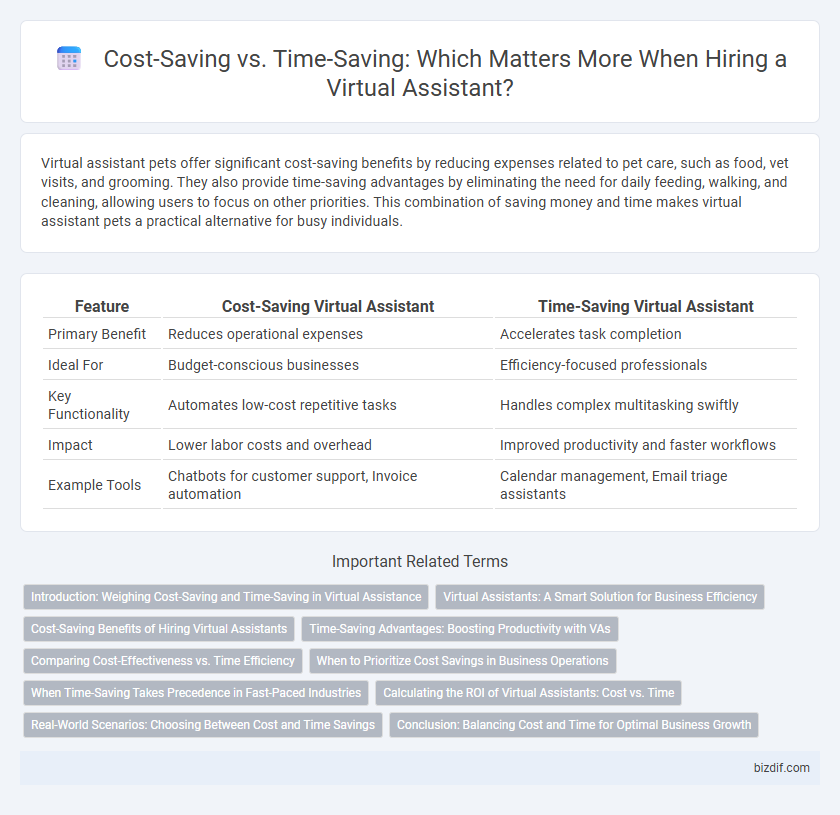Virtual assistant pets offer significant cost-saving benefits by reducing expenses related to pet care, such as food, vet visits, and grooming. They also provide time-saving advantages by eliminating the need for daily feeding, walking, and cleaning, allowing users to focus on other priorities. This combination of saving money and time makes virtual assistant pets a practical alternative for busy individuals.
Table of Comparison
| Feature | Cost-Saving Virtual Assistant | Time-Saving Virtual Assistant |
|---|---|---|
| Primary Benefit | Reduces operational expenses | Accelerates task completion |
| Ideal For | Budget-conscious businesses | Efficiency-focused professionals |
| Key Functionality | Automates low-cost repetitive tasks | Handles complex multitasking swiftly |
| Impact | Lower labor costs and overhead | Improved productivity and faster workflows |
| Example Tools | Chatbots for customer support, Invoice automation | Calendar management, Email triage assistants |
Introduction: Weighing Cost-Saving and Time-Saving in Virtual Assistance
Virtual assistants deliver significant cost-saving benefits by reducing the need for full-time staff and minimizing overhead expenses. Time-saving advantages arise from streamlined task management, allowing businesses to focus on core activities more efficiently. Balancing these factors is crucial for optimizing productivity and achieving the best return on investment.
Virtual Assistants: A Smart Solution for Business Efficiency
Virtual assistants significantly reduce operational costs by automating routine tasks such as scheduling, email management, and customer support, enabling businesses to allocate resources more strategically. These AI-powered tools also enhance time efficiency by streamlining workflows and enabling rapid task completion without human error. Investing in virtual assistant technology drives both financial savings and productivity improvements, making it a smart solution for business efficiency.
Cost-Saving Benefits of Hiring Virtual Assistants
Hiring virtual assistants significantly reduces operational costs by eliminating expenses related to office space, equipment, and employee benefits. Virtual assistants offer flexible work arrangements that allow businesses to scale support based on demand without incurring additional overhead. Leveraging virtual assistants boosts productivity while maintaining budget efficiency, making it a strategic cost-saving solution.
Time-Saving Advantages: Boosting Productivity with VAs
Virtual assistants significantly enhance productivity by efficiently managing routine tasks such as scheduling, email sorting, and data entry, allowing professionals to focus on high-priority work. Time-saving advantages of virtual assistants lead to faster project completion and reduced workload stress. Businesses that leverage virtual assistant services often experience improved operational efficiency and accelerated decision-making processes.
Comparing Cost-Effectiveness vs. Time Efficiency
Virtual assistants provide a cost-effective solution by reducing the need for full-time staff and minimizing overhead expenses. Time efficiency is enhanced as they quickly handle routine tasks, allowing businesses to focus on core activities. Balancing cost-effectiveness and time-saving measures depends on specific operational priorities and workload demands.
When to Prioritize Cost Savings in Business Operations
Prioritizing cost savings in business operations is essential when managing tight budgets or facing cash flow constraints to maintain financial stability. Small businesses or startups benefit most from cost-saving measures by reducing overhead expenses without compromising core functions. Strategic outsourcing and automation of repetitive tasks can minimize costs while allowing limited resources to focus on growth and innovation.
When Time-Saving Takes Precedence in Fast-Paced Industries
In fast-paced industries such as finance and healthcare, virtual assistants prioritize time-saving to enhance productivity and decision-making speed. Automating routine tasks like scheduling and data retrieval reduces downtime, allowing employees to focus on critical projects and client interactions. This efficiency gain often outweighs direct cost savings by accelerating project timelines and improving service delivery.
Calculating the ROI of Virtual Assistants: Cost vs. Time
Calculating the ROI of virtual assistants involves analyzing both cost-saving and time-saving benefits by quantifying reduced labor expenses and increased productivity. Businesses can measure savings through metrics such as hours saved on repetitive tasks and the corresponding decrease in employee overtime or outsourcing costs. Evaluating these factors provides a clear financial impact and helps justify investment in virtual assistant technology.
Real-World Scenarios: Choosing Between Cost and Time Savings
Virtual assistants streamline operations by reducing labor costs and accelerating task completion, providing measurable savings in both time and money. In real-world scenarios, small businesses often prioritize cost-saving by automating customer support, while enterprises focus on time-saving to boost productivity and meet tight deadlines. Selecting between cost and time savings depends on project scope, budget constraints, and the value placed on efficiency versus expenditure reduction.
Conclusion: Balancing Cost and Time for Optimal Business Growth
Balancing cost-saving and time-saving strategies through a virtual assistant drives optimal business growth by maximizing efficiency without overspending. Prioritizing automation for routine tasks reduces operational costs while freeing up valuable human resources to focus on strategic initiatives. Integrating scalable virtual assistant solutions ensures sustainable growth by harmonizing budget constraints with productivity enhancements.
Cost-saving vs Time-saving Infographic

 bizdif.com
bizdif.com